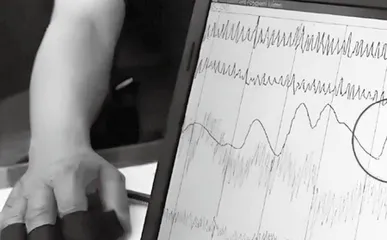How Lie Detectors Work测谎仪的工作原理

Most people lie. Some might argue it’s human nature. In a study, 60% of people were found to lie at least once during a 10-minute conversation. Some lies are small, some are bigger, some are done out of kindness, and some are done out of malice. But a lie is a lie, and the way that your body reacts when you lie is almost the same.
大多数人都会撒谎。有些人可能会说这是人性使然。一项研究发现,在一场10分钟的谈话中,60%的人至少会说一次谎。有些谎言很小,有些则很大;有些出于善意,有些则出于恶意。但谎言就是谎言,说谎时你身体的反应几乎都是一样的。
When you engage in a lie, your respiratory and heart rate will increase and you may even start to sweat. While people may vary in the ability to tell a lie, most of the time your body will react in this same way. Exceptions to this rule are, for example, psychopaths, who lack empathy and therefore do not exhibit the typical physiological stress responses when telling a lie.
当你在说谎时,你的呼吸频率和心率会加快,甚至还可能会开始出汗。虽然人们的说谎能力各不相同,但大多数时候身体的反应是相同的。不过也有例外,比如精神病患者,他们缺乏同理心,因此在说谎时不会表现出典型的生理应激反应。
Lying generally involves more effort than telling the truth, and because of this, it involves the prefrontal cortex. A 2001 study by neuroscientist Sean Spence explored fMRI images of the brain while lying. Participants answered questions about their daily routine by pressing a yes or no button on a screen. The results showed participants needed more time to make up a dishonest answer than an honest one, and certain parts of the prefrontal cortex were more active when they were lying.
说谎通常比说实话需要花更多心力,正因为如此,说谎会动用前额叶皮层。神经科学家肖恩·斯宾塞在2001年的一项研究中探究了说谎时大脑的功能性磁共振成像图。受试者通过按屏幕上的“是”或“否”按钮来回答有关他们日常生活的问题。结果显示,比起一个真实的回答,受试者需要更多的时间来编造一个不实的回答,并且当他们说谎时,前额叶皮层的某些区域会比平常活跃。
Further research explains that three main areas of the brain are stimulated during deception—the frontal lobe, the limbic system, and the temporal lobe.
进一步的研究表明,在说谎时,大脑的三个主要部位——额叶、边缘系统和颞叶会受到刺激。
In 1921, a California-based police officer and physiologist John A. Larson created a piece of equipment that simultaneously measures continuous changes in blood pressure, heart rate, and respiration rate to aid in the detection of deception. This was the invention of the polygraph, which is commonly referred to as a lie detector.
1921年,加利福尼亚州的一名警察兼生理学家约翰·A·拉尔森发明了一种仪器,可以同时测量血压、心率和呼吸频率的连续变化,来辅助判断是否撒谎。这就是多种波动记录仪的由来,通常称其为“测谎仪”。
The accuracy of polygraph tests has been called into question for nearly as long as they’ve existed. These machines detect typical stress responses to telling a lie. This means increased heart rate, blood pressure, and respiration rate. Some people are naturally good liars, or become better with controlling these stress responses, and can manage to stay calm during a lie detector test. While some people may feel anxious wearing the device and therefore emitting the elevated heart, respiratory, and blood pressure rates that can be detected. According to the American Polygraph Association, the estimated accuracy of a polygraph can be up to 87%.
自测谎仪问世以来,其准确性一直备受质疑。这些仪器能监测到说谎时的典型应激反应,即血压升高、心率和呼吸频率加快。有些人天生擅长撒谎,或者善于控制这些应激反应,在接受测谎仪的监测时能够保持冷静。但是有些人可能会因为接上测谎仪而感到焦虑,有心率和呼吸频率加快、血压升高的表现,从而被监测到。据美国测谎协会称,测谎仪估计的准确度可达87%。
Word Bank
respiratory /rə'spɪrətri/ adj. 呼吸的
empathy /'empəθi/ n. 同理心;共鸣
simultaneously /'sɪml'teɪniəsli/ adv. 同时进行地;同步地
call sth into question 怀疑;引起怀疑
The planet’s existence was quickly called into question.